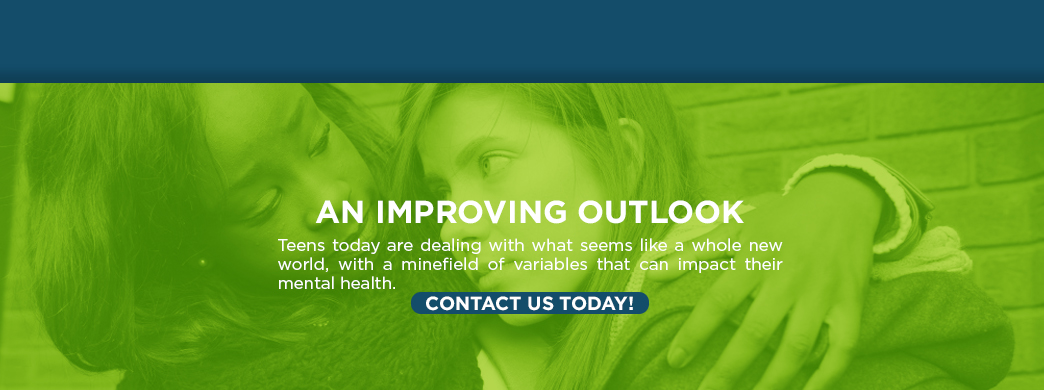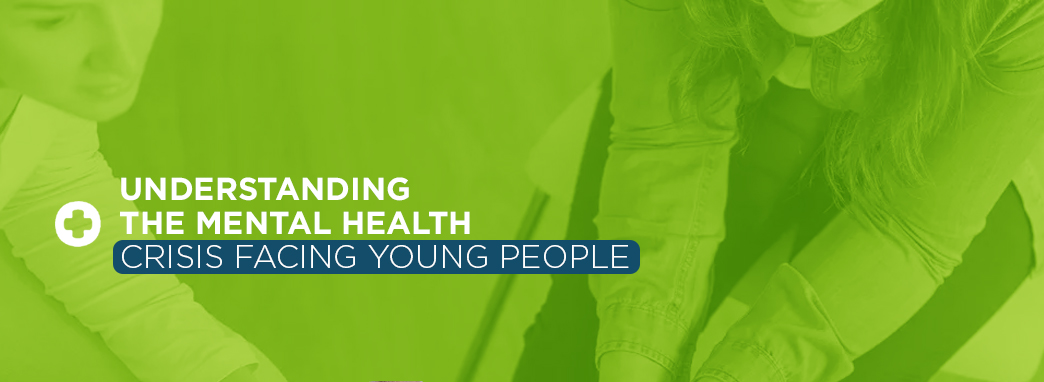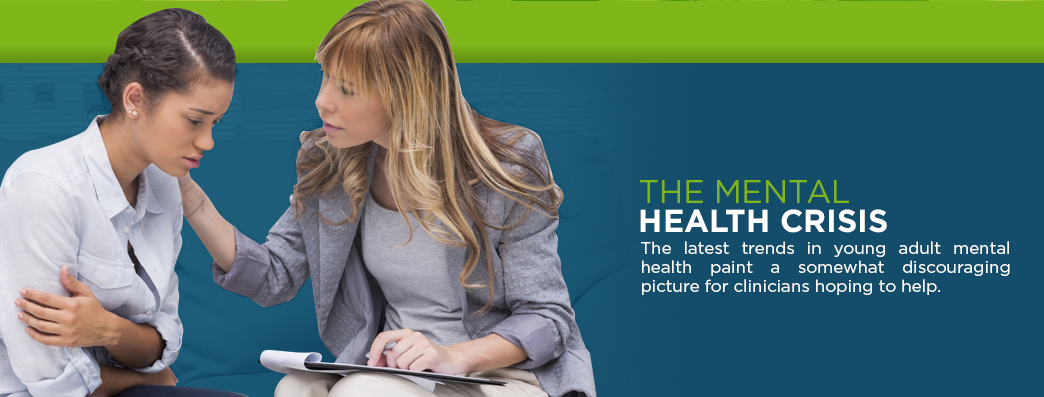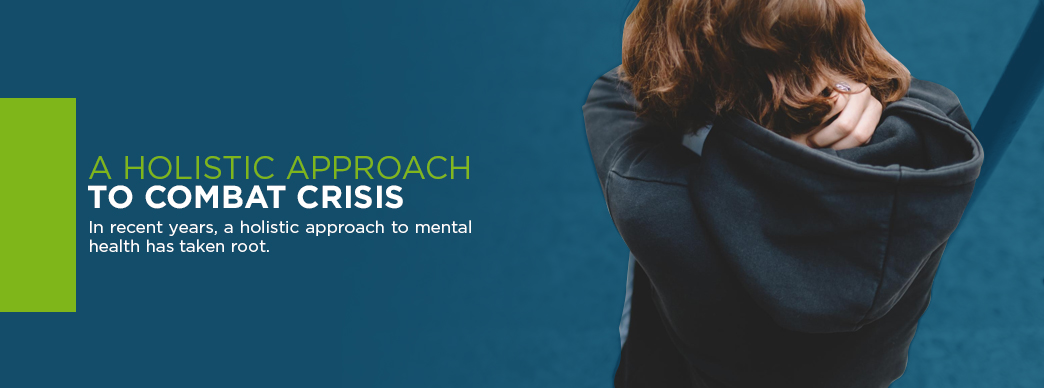Understanding the Mental Health Crisis Facing Today’s Youth
Today’s teens and young adults are making their way in a world much different than the one their parents experienced. Navigating constant developments in technology and social media while coping with an uncertain future takes a toll on young people. We’re reaching record levels of mental health issues in our youngest generation.
Fortunately, depression and anxiety in young adults are highly treatable as long as they receive proper mental health care. Understanding the scope of this crisis and the drivers behind it is key to better treatment of teen mental health problems.
Table of Contents
- The Mental Health Crisis in Today’s Youth
- Explaining This Epidemic & The Decline in Teen Mental Health
- Implications and Effects of Teen Mental Health Problems
- A Holistic Approach to Combat the Youth Mental Health Crisis
- Improving the Outlook for Teen Mental Health
The Mental Health Crisis in Today’s Youth
The latest trends in young adult mental health paint a somewhat discouraging picture for clinicians hoping to help. Research from Johns Hopkins University has found that the rate of adolescents who report major depressive episodes within the past 12 months has risen significantly in recent years. The study relied on the self-reporting of 176,2455 young people aged 12 to 17.
- In 2005, 8.7 percent of adolescents reported major depression.
- In 2014, 11.3 percent reported major depression.
This research indicates a 37 percent increase in the reporting of depression — a significant jump in just under 10 years. Notably, the research specifies that the percentage of teens reporting depression remained fairly steady from 2005 to 2011, but rose suddenly and significantly from 2011 to 2014.
Anxiety is the leading cause of disruption to young adult mental health. Among children ages 6 to 17, diagnoses of anxiety shot up 20 percent from 2007 to 2012. The situation is even bleaker for kids on the cusp between high school and college. The Higher Education Research Institute at the University of California, Los Angeles (UCLA) has been asking their incoming freshmen if they feel overwhelmed by all their new daily tasks since 1985. Here’s the percentage progression of students who replied “yes” through the years:
- In 1985, 18 percent of students felt overwhelmed.
- In 2000, 28 percent felt overwhelmed.
- By 2016, nearly 41 percent of incoming students felt overwhelmed.
Feeling overwhelmed by everyday tasks is a hallmark of anxiety, and the immense increase seen at UCLA is a somber indicator of what’s happening to kids all around the country. Unfortunately, the increase in depression and anxiety has also coincided with a rise in suicide rates.
The Centers for Disease Control and Prevention (CDC) conducted a study analyzing the suicide rates of teens from 1975 to 2015. Zeroing in on the years 2007 to 2015, researchers found that:
- Rates of suicide in boys grew from 10.8 to 14.2 per 100,000.
- Rates of suicide in girls grew from 2.4 to 5.1 per 100,000.
The rate for boys went up more than 30 percent, and the rate for girls doubled. For girls, the suicide rate in 2015 reached a 40-year high. There’s heavy speculation about the cause of this mental health crisis, but the impact on kids is one that deserves the full attention of the behavioral health community.
Explaining This Epidemic & The Decline in Teen Mental Health
What is it that’s driving these sweeping declines in young adult mental health? The number of factors influencing mental health is huge and fluctuates among individuals. Genetic predisposition and different environments are reasons some adolescents are more likely to struggle with mental health. However, five factors are common to almost every young adult’s life and can contribute to depression and anxiety.
1. Busy Schedules and Academic Pressure
School and extracurricular activities are a huge source of stress that can lead to student mental health problems. In an American Psychological Association (APA) survey, teens reported that their levels of stress during the school year were much higher than they thought to be healthy. On a 10-point scale, 3.9 was the maximum level of stress considered to be healthy. The average of all the teen responses rated school-year stress at a 5.8, which was even higher than the 5.1 average of the adults in the survey.
Kids are feeling more and more pressure to perform academically, and the competition for the highest GPA or best portfolio of extra-curricular activities can wear them down quickly. A Stanford study of students in high-achieving communities found that 56 percent of students consider homework one of their primary sources of stress, and less than one percent said homework didn’t stress them out.
High school teachers in a survey by the University of Phoenix reported giving out an average of 3.2 hours of homework per week. Assuming that the average high school student has five teachers to cover a variety of subjects, students are facing an average of 17.5 hours of homework per week.
On top of transportation time and the need to work in meals, socializing and hobbies, kids have a real budget balancing act when it comes to time. Without significant guidance in time management, the stress can quickly lead to depression and anxiety in young adults.
2. Social Media Comparison
There has been considerable panic about the effects of social media on developing young adult brains, and research is showing that there’s a significant link between heavy social media use and teen mental health problems. One study found that young adults 18 to 22 who were assigned to limit their social media use to 10 minutes a day ended up showing significant reductions in anxiety and “Fear of Missing Out” (FOMO).
FOMO is a major component of social media comparison. When teens see their friends posting perfect photos of parties, adventures and accomplishments, they can develop a sense of fear and paralysis that leads to pronounced anxiety. Teens may get trapped in repetitive thought cycles that question whether they are “good enough” on a variety of levels.
Instagram is ranked as the worst social media platform for mental health, according to a survey by the Royal Society for Public Health. Nearly 1,500 teens and young adults ranked five social networks on the basis of 14 different issues, including emotional support, body image, anxiety, depression and FOMO. As an image-based platform, Instagram provides a steady feed of the most unrealistically perfect photos with the least context — a deadly combination for teens’ self-esteem and mental health.
3. Inadequate Coping Skill Development
Young people are very vulnerable as they continue to develop coping skills. The development of resilience is necessary to effectively handle the unexpected situations life can present, and not enough teens receive the support they need to become resilient. Because many mental disorders emerge during adolescence, having the right coping skills can prevent emergent mental health problems from spiraling out of control.
Maladaptive coping skills, such as overeating or consuming too much media, must be arrested as early as possible to ensure they don’t turn into lifelong habits that worsen mental health in the long run.
4. Engaging in Risky Behaviors
Some maladaptive coping skills come in the form of risky behavior. Teens are known for engaging in somewhat reckless behavior, and sometimes parents fail to recognize when these behaviors start getting out of control. The CDC monitors risky teen behavior with the Youth Risk Behavior Surveillance System (YRBSS), documenting trends with the goal of reducing these six behaviors in young adults:
- Alcohol and other drug use
- Tobacco use
- Inadequate physical activity
- Unhealthy dietary behaviors
- Behaviors that contribute to violence and unintentional injuries
- Sexual behaviors related to sexually transmitted diseases and unintended pregnancy
The 2017 YRBSS results are somewhat of a mixed bag. For instance, fewer teens are engaging in sex, and rates of both teen pregnancy and smoking hit an all-time low. On the other hand, the new question on opioid use shows that 14 percent of teens have misused a prescription opioid.
Monitoring risky behavior in teens is an important step in preventing those behaviors from causing lasting damage to young adult mental health. Risk behaviors can quickly spiral into a cycle where the behavior causes or worsens a mental illness.
5. Difficulty Navigating Relationships
Adolescent relationships of all varieties are fraught with stressors that can produce or aggravate negative mental health symptoms. According to a study of more than 46,000 adolescent counseling sessions, concerns about family relationships were the primary reason for counseling 13.3 percent of the time, and romantic relationships were the primary source of concern 8.7 percent of the time.
Due to their personal nature, romantic relationships can be a hidden source of stress that can lead to depression and anxiety in young adults. The previous study noted that the dissolution stage of a relationship is associated with greater risk of mental illness, self-harm and suicide.
Implications and Effects of Teen Mental Health Problems
Teens with anxiety, depression and other disorders face problems in other areas of life due to their mental illness. When mental health issues are left untreated, individuals can face a slew of long-term effects. Blue Cross Blue Shield’s Health of America Report examined the effect of major depression on health and came up with these crucial findings:
- Future chronic illness: People with depression are very likely to struggle with other health conditions. A full 85 percent of people with major depression have also been diagnosed with at least one other chronic health condition, and nearly 30 percent are dealing with four or more at the same time.
- Worsened health throughout life: People with depression use healthcare services more than others. The study reported more than double the healthcare spending and revealed that people with major depression are almost 30 percent less healthy than their counterparts. Overall, that takes away 10 years of healthy life.
- Further mental health disorders: A different study revealed that major depression is highly comorbid with other disorders. Among individuals with a lifetime history of depression, 57.9 percent had a history of substance use disorder, 37.3 percent reported experience with anxiety, and 31.9 percent reported having struggled with a personality disorder.
Many young people can develop ways to cope with and manage mental health problems with the right intervention and support. Without the proper treatment, persistent depression and other mental illness are likely to get worse and trigger additional negative health developments. The earlier parents and adolescents spot symptoms and seek treatment, the better behavioral health professionals can prevent mental illness from damaging a young person’s lifelong health.
A Holistic Approach to Combat the Youth Mental Health Crisis
In recent years, a holistic approach to mental health has taken root. By addressing the complexities and interconnected nature of both body and mind, a holistic program aims to nurture the whole person. This approach helps give the patient the tools they can carry throughout life to combat their mental illness. There are three central daily practices patients can take on to improve their mental health:
- Exercise: The physical health benefits of exercise have been evident for millennia, and now studies are showing the impressive advantages it has for mental health as well. Fewer than one in 10 teens get enough exercise, and this statistic is almost certainly contributing to rising rates of depression and anxiety.
- Nutrition: It’s not always easy for teens to get the balanced diet they need to maintain their mental health. About 95 percent of serotonin is produced in the digestive system, so what teens eat really matters. Diets high in vegetables, unprocessed grains, fruits, fish and seafood can lower a person’s risk of depression by 25 to 35 percent.
- Mindfulness: Getting teens to practice mindfulness can help them cope with the symptoms of mental illness. Mindfulness practices cultivate self-awareness and a calmer, more controlled way to process emotions. The great thing about mindfulness is that it can come in all shapes and sizes, from yoga to running to meditation.
While these approaches provide patients with tools they can incorporate into their daily lives, there is simply no substitute for therapy. Regular visits to a behavioral health professional offer young people the chance to learn and develop healthy habits under the guidance of an expert. Many young adults are reluctant to participate in therapy due to fear of stigmatization, but the benefits can’t be overstated.
Therapy offers teens a safe space in which they can discuss private subjects they might not otherwise acknowledge. Whether it’s group, individual or family therapy, teens benefit from structured, focused attention to their mental health.
Improving the Outlook for Teen Mental Health
Teens today are dealing with what seems like a whole new world, with a minefield of variables that can impact their mental health. The good news is that growing awareness is making more teens and parents aware of potential problems, and more resources are available than ever before. With adequate care and support, young people can live healthy lives while coping with mental illness.
From a behavioral health professional’s point of view, finding new ways to improve care is a central mission. One technology that can drastically improve the quality of care is ICANotes, the most clinically robust behavioral health EHR available. Our fully configured system eliminates the time and effort needed to create documentation for your patients by allowing you to simply point and click to fill in all the necessary information. We’ve also integrated more than 75 rating scales and assessment tools to make it even easier to develop a complete picture of your patient’s mental health.
With greater accuracy and the ability to customize content for your patients’ specific needs, you can draw up a clearer picture of each patient’s development and requirements with regulatory compliance built in. To see how ICANotes can improve your quality of care for patients in every age demographic, you can schedule a live demonstration online or request a free trial today.
Related Posts
The Importance of the Senate Expanding Training for School Mental Health Professionals
Addressing Mental Health Issues in School Leads to Improved Performance
Tips for Improving Mental Health in Young Adults
What Are the Most Common Mental Health Disorders in the United States?
Sources:
- https://www.jhsph.edu/news/news-releases/2016/depression-rates-growing-among-adolescents-particularly-girls.html
- https://www.cdc.gov/mmwr/volumes/66/wr/mm6630a6.htm
- https://journals.lww.com/jrnldbp/Citation/2018/06000/Epidemiology_and_Impact_of_Health_Care.6.aspx
- https://www.heri.ucla.edu/monographs/TheAmericanFreshman2016.pdf
- https://www.apa.org/news/press/releases/2014/02/teen-stress
- https://news.stanford.edu/2014/03/10/too-much-homework-031014/
- https://www.phoenix.edu/news/releases/2014/02/survey-reveals-how-much-homework-k-12-students-are-assigned-why-teachers-deem-it-beneficial.html
- https://guilfordjournals.com/doi/10.1521/jscp.2018.37.10.751
- https://www.rsph.org.uk/about-us/news/instagram-ranked-worst-for-young-people-s-mental-health.html
- https://www.cdc.gov/healthyyouth/data/yrbs/index.htm
- https://www.cdc.gov/healthyyouth/data/yrbs/pdf/trendsreport.pdf
- https://www.ncbi.nlm.nih.gov/pmc/articles/PMC4931381/
- https://www.bcbs.com/the-health-of-america/reports/major-depression-the-impact-overall-health
- https://www.psychcongress.com/article/depressions-most-common-comorbidities



